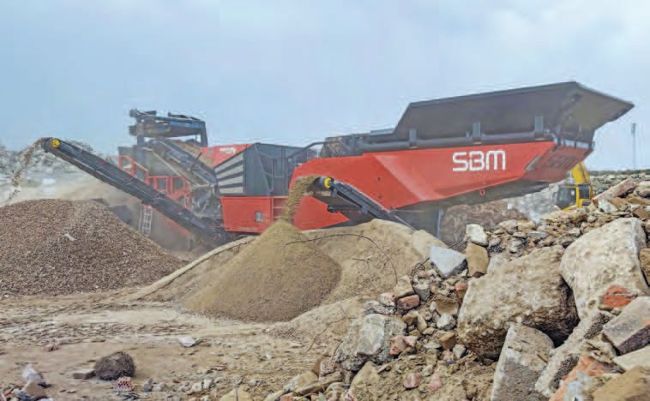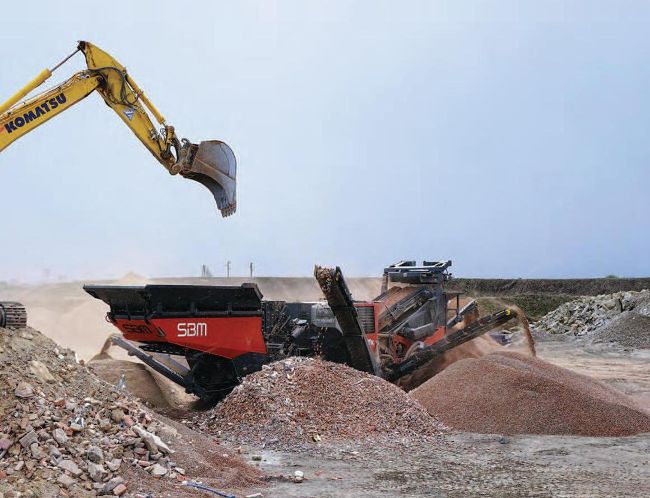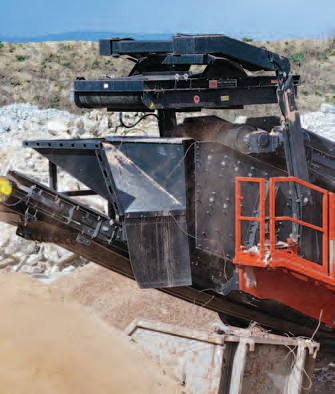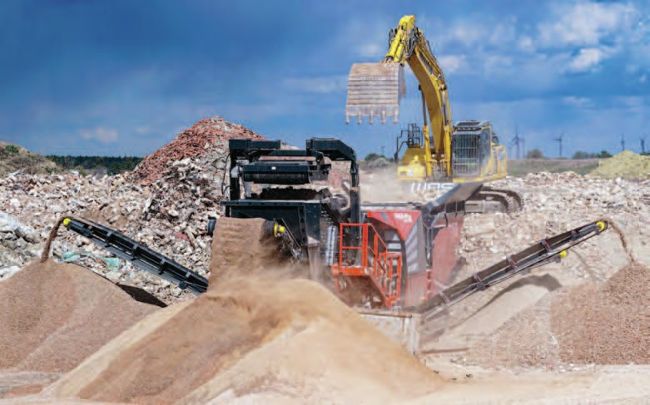CRUSHERS
Future project three years in the making
A look at how crushers are making a difference in two very different environments, starting with SBM Mineral Processing’s Remax 600 impact crusher and the autonomous crushing that it is working towards.

The machine is said to process tens of thousands of tonnes in a range of materials
If the future of crushing is a combination of simplifying the process to avoid people shortages while embracing the best features of artificial intelligence, SBM Mineral Processing can be said to have put down a marker with its latest product. At the same time, though, the Austrian company’s Remax 600 track-mounted impact jaw crusher is far from a knee-jerk reaction to the latest trends.
“As well as dealers, our first end-customers are already signed up”
By SBM’s own admission, the company spent three years developing the machine, a process that Helmut Haider, sales manager processing, described as “intensive development work” involving both its own people and external experts.
Last October, the Remax 600 made its first public appearance at the Bauma trade show in Germany, another step in SBM’s development of “autonomous crushing”. On 11 May 2023, SBM took the next logical step, an international market launch that gave customers and dealers the opportunity to see the crusher up close in a working environment.
Fittingly, the manufacturer stayed on home soil this time. The venue was one of four quarries and three recycling plants owned by partner organisation Hans Zöchling, based 70 km (43 miles) south-west of the capital Vienna that includes construction, civil engineering and demolition among its services.
SELF-LEARNING CRUSHERS
Zöchling was not the only partner of SBM to feature at the launch.
The company has also cooperated closely with Austria’s Montanuniversität of Leoben. With fewer than 3,500 students, it is relatively small, but its chair of mineral processing is second to none and the parties have worked together for several years.
Part of this work has majored on computer-aided validation of new components and processing solutions, ultimately to develop “intelligent”, selflearning mobile crushers. In terms of the Remax 600, the latest generation of the Crush Control system already processes a large part of machine-generated data.
But with the next move in mind, the teams are working on advanced sensor technology that will enable the machine to automatically detect the type and composition of the end products, along with load conditions of the crusher and conveyors, which are transmitted via a cloud solution back to SBM.

Since the start of the year, SBM partner Hans Zöchling has been testing the Remax 600 under operating conditions d&ri APRIL-JUNE 2023 19
ALL PHOTOS: SBM
This is where the SBM Redbox AAI digital twin comes in. It transfers the information to the company’s digital lab in Austria and the university in Leoben, every five seconds.
Using what SBM calls “the highest level of health, safety and environmental control”, Red Box AAI and Crush Control combined mean there is no need for an operator to be next to or even near the machine.
A further feature aimed at making the machine easier for relatively inexperienced people to use is that the feeding intervals into the crusher are communicated from the mobile crushing plant to the loader operator is via a traffic light system.
As well as the conceptual thinking behind the product, there are several physical considerations that SBM believes will be welcomed by the market.
It features a diesel-electric hybrid drive with optional mains operation, while tests at Zöchling’s Ramsau quarry resulted in average values of 34 to 46 l/hr diesel or electricity consumption between 140 and 200 kWh. An asphalt crushing demonstration on the day of the launch produced outputs of over 400 t/hr.

The overbelt magnet with longitudinal discharge above the main conveyor

Stockpiles under the product conveyors have a capacity of up to 200 t
The Remax 600 offers a package of standard and optional equipment. In addition to the standard pre-screening through a double-deck circular vibratory screen, there are three optional circular vibratory post-screening units – one-, twoor three deck and measuring 1,800 x 5,500 mm (70 to 216 in) – each with oversize return and high-projecting discharge conveyors for large product stockpiles, while the transport weight of between 60 and 80 t depending on the equipment used also speaks to the central idea of the crusher as a mobile plant, as it does its ability to produce up to five fractions in one pass.
CONSUMPTION ADVANTAGES
As for the future the Remax 600, and by extension that of autonomous crushing, SBM is optimistic.
“The advantages in consumption were undoubtedly one of the reasons why the enthusiasm felt at the Bauma trade fair very quickly turned into real interest and concrete orders long before the market launch,” says Helmut Haider.
“In addition to our own dealers, the first end customers have already signed up. We assume that we may significantly adjust our production plans for the Remax 6000 upwards next year.” ■
Antarctic adventure for Sandvik mobiles
Three Sandvik mobile crushers and screens have been deployed in the Antarctic, as part of the United Kingdom’s £300 million (US$378 million) Antarctic Infrastructure Modernization Programme (AIMP) for the British Antarctic Survey (BAS).
A Sandvik QH332 Hydrocone crusher and a QA335 Doublescreen were ordered by contractor BAM Ritchies for a runway resurfacing project at the Rothera Research Station, where modernisation works and the construction of a new science and operations facility - known as the Discovery Building - are underway.
“BAM were in need of a processing train to crush and screen the abrasive granodiorite material so it could be recycled and reused for construction purposes at the research station,” said Sandvik.
The Hydrocone crusher and the Doublescreen joined a previously delivered QH341 jaw crusher at the polar site, where temperatures rarely get above freezing.
“Living and working in the Antarctic is no mean feat and with temperatures ranging from 5°C to -40°C, it poses many environmental challenges,” said Sandvik.
The company fitted each of the mobile units, which weigh between 26.5 and 50 t, with an arctic package.
Sandvik added that “For this particular application and job at hand, a Sandvik QH332 Hydrocone crusher and QA335 Doublescreen were selected due to their versatility and performance capacity.
The QH332 crusher and the QA335 Doublescreen are being used to crush the runway’s existing surface material down to make resurfacing material for an 800 m (2,624 ft) unpaved gravel runway.